As a novice SEO doing the marketing for a commercial cleaning company, SEO was probably something the owner never considered, up until the referrals dried up.
It was great at first. Cleaning commercial spaces left and right, getting referred to several businesses here and there. But at some point the leads just stopped coming.
And now you’ve been hired. What if someone told you, you didn’t need to have the tools and resources of an SEO agency to get results for your client’s website? Yes, SEO is a long-term investment and the value you get from expensive SEO packages is undeniable.
But the thing is, your client doesn’t have the budget. Not just yet at least. So what can you do? A little bit of in-house SEO magic.
This is a comprehensive guide on SEO for commercial cleaning companies on a budget. We cover all tips, involving free and paid options so you really have a full arsenal of SEO strategies at your disposal.
Let’s get right to it.
Look for Low-Competition, High Search Intent Local Keywords
If you have a new commercial cleaning site, you don’t want to target keywords your competitors who have long been in the industry are using.
Instead, you want low-competition keywords that are still relevant to the business’ services, but enough for the site to “potentially” rank for.
Many free (but limited) keyword research tools offer insights into the competitiveness or the difficulty of ranking for a particular keyword.
Keyword research via ahrefs
Look at the KD or keyword difficulty, and the DR or the domain rating of your competitors. Aim for commercial intent keywords with an average KD that is more or less equal to the site and already ranking for competitors with comparable DRs.
To get your DR, plug in your domain at their “Website Authority Checker” page. To get your competitor’s DRs, get the domains of your top 3 competitors, plug them all one-by-one into the “Domain Checker” tool.
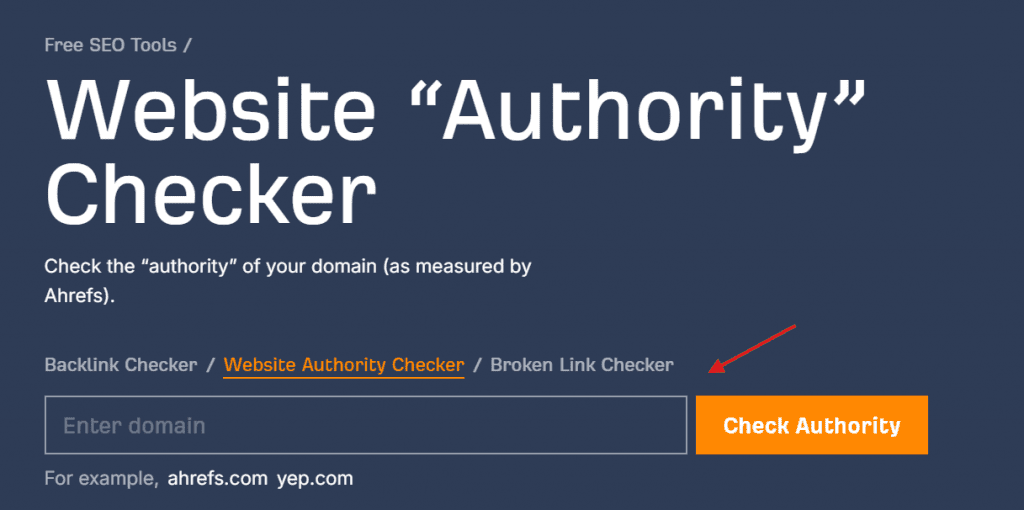
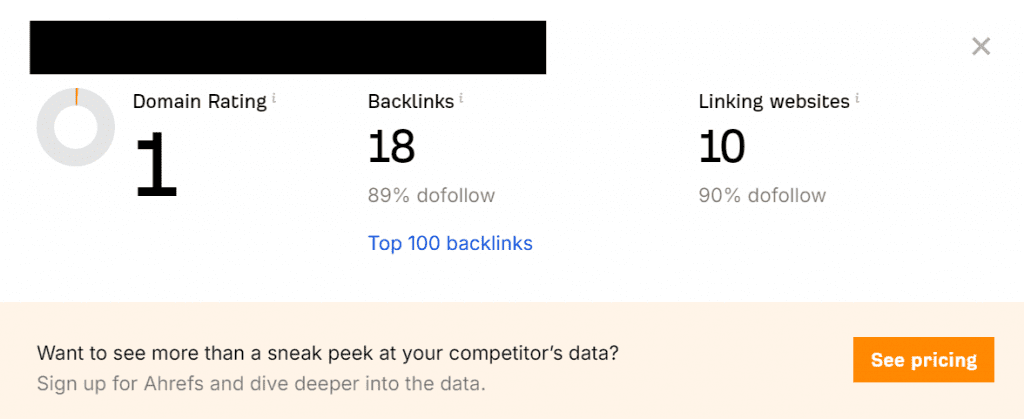
Now for the exciting part. Choose keywords with the same criteria. For example, as a commercial cleaning niche, you typically don’t want to go for local keywords like “commercial cleaning in [location]”, or “commercial cleaning services” as these are highly competitive and established businesses have the lion’s share of traffic for them.
Go deeper and niche it down further. Something like “commercial cleaning for [industry]” or “commercial cleaning in [very specific city]” is a good starting point.
Ranking for such keywords is much easier and has a high potential for traffic.
Visit the Keyword Difficulty Checker tool and view data about your selected keyword. See if you can target this for your website

Keyword research via Ubersuggest
Ubersuggest also has a great suite of free, but limited SEO tools. The metrics are pretty much the same as for ahrefs. The only difference is with the naming convention.
Sign up for a free account first, then follow the instructions. Once you’ve set it up, do the steps below:
- Go to the Traffic Estimation > Traffic Overview tab. Plug in your domain, and check your Domain Authority score.

2. Once you have this figured, go to the Keyword Research > Keyword Ideas tool. Make sure the “SEARCH BY KEYWORDS” tab is toggled. Hit search.

3. Look for those with high commercial intent, but with an SD or SEO Difficulty in the “Easy” range (usually 0-35 for Ubersuggest). Use the SEO Difficulty filtering to get targeted results.
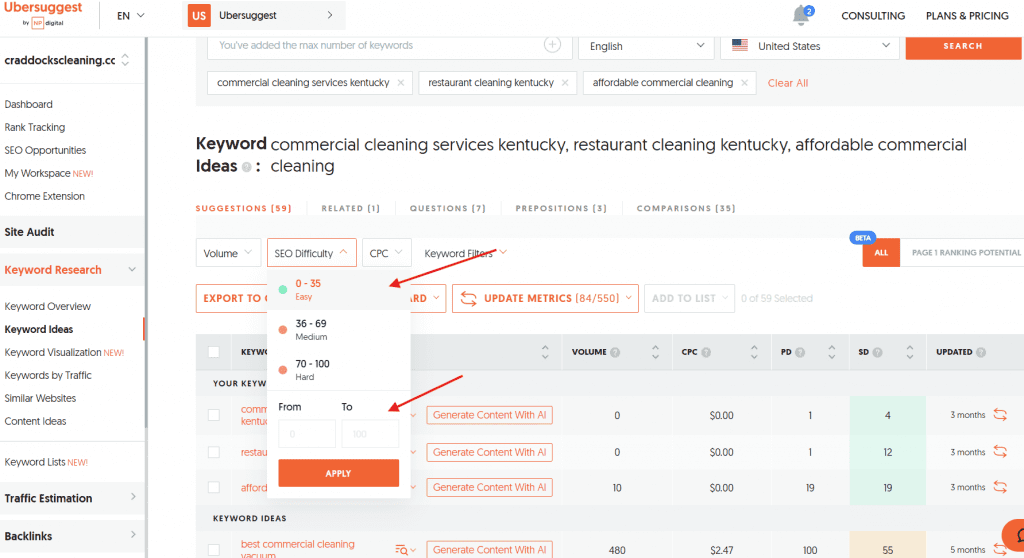
4. Export or copy and paste the data onto a sheet as reference.
5. Write the content for it, making sure you have all on-page SEO basics on point.
On-Page Optimization
On-page optimization for a commercial cleaning company doing SEO boils down to these key factors:
Title tags
Your keywords should be seamlessly inserted in the title tags in an organic, and non-awkward manner. Most commercial cleaning companies target local keywords, so make sure the insertion of the location makes sense.
Aim for a title tag length of about <65 characters to avoid being truncated on the SERPs (Search Engine Results Pages)
Tip: You can change a page’s meta data (title tags and meta description) through an SEO plugin like Rank Math or Yoast. Both are good, but Rank Math does have a lot more features in its free version.

Meta description
Many SEO agencies will tell you to make your meta description high-CTR by using clickbaity descriptions with phrases like: “Revealed!”, “Secrets finally unveiled”, “You won’t believe these..”. You get the point.
This is bad for user experience. The point of the meta description is not to stand out but to describe what’s on the page in under 155-160 characters.
Heading tags
Although Google has said having multiple H1 tags on a page is not a problem, you generally only want to have one H1 tag. Then, the logical structure should be something like this:
-
H1: Main Title
-
H2: First Main Point
-
H3: Sub-Point to First Main Point
-
-
There must be a logical sequence to how you organize ideas in your content. Plus, it’s also good for user experience to divide content into manageable parts so your users can digest them all in piecemeal instead of in one long block of text.
Content
Focus on long-tail keywords for your blogs. Unlike what other articles say, long-tail doesn’t mean keywords with more than 3 words. Long-tail refers to the position of the keyword in the search demand curve.
Almost always, but not all the time, long-tail keywords are less in popularity, but highly specific. Think keywords like “are commercial cleaning companies worth it” or “what’s the difference between janitorial and commercial cleaning services”.
These are high in user intent, meaning keyword research tools might not show data for them, but people do search for them.
Site structure
Like your content, the site should have a logical structure to it. Is there a sequential breadcrumb trail of where each page leads and where they originate?
For example, your homepage will have a main menu or navigation. Look at the dropdowns of each link. Does it make sense to have certain links to pages there?
You might have a main “Services” link but the links lead to blog posts. This is confusing for the user and so you’ll want to change the link to the correct page.
If you have an “Industries” link for instance, is the link crawlable or clickable? Does it lead to a main parent page with the rest of the links to the actual industry child pages?
These are just some of the considerations when it comes to the site structuring for the site.
Site speed
Google rewards websites that provide the best user experience possible to the users. Site speed is one factor and is actually something you should prioritize.
You may have an awesome website design but if it loads poorly on desktop, tablets, and mobile devices, it won’t matter.
A good way to check your page speed and performance is through PageSpeed Insights. Here you’ll get valuable information such as the FCP (First Contentful Paint), LCP (Largest Contentful Paint), and CLS (Cumulative Layout Shift).
PSI also suggests ways to improve your scores on each metric. Expand these suggestions and have a developer look into them in the future. But let’s go with the basics for now.
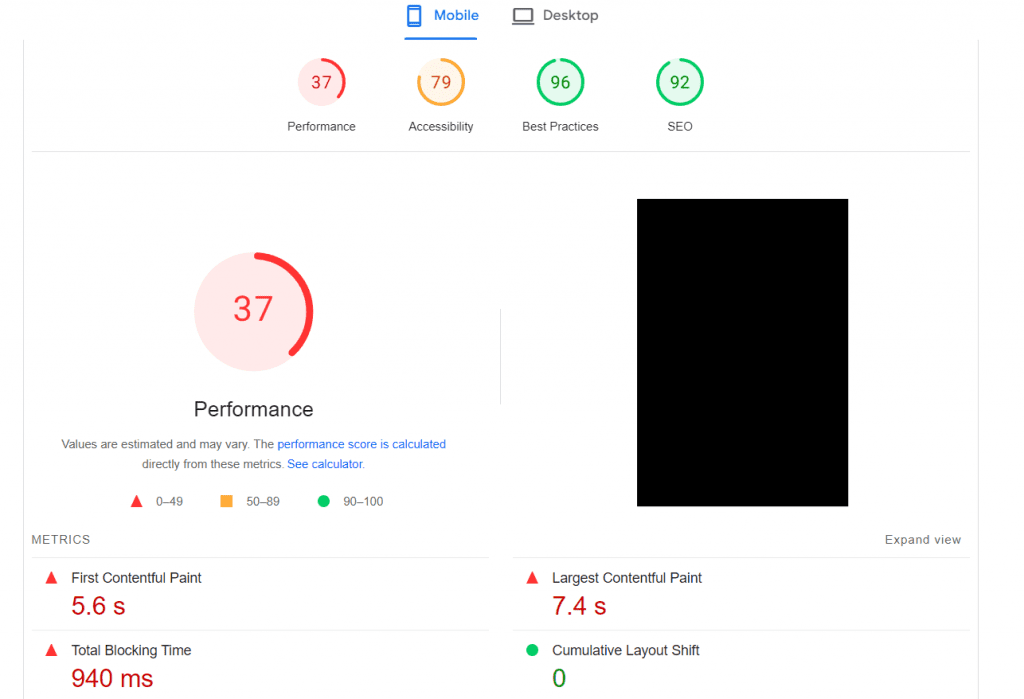
If you score Red or Orange on these metrics, it’s a sign you should improve the site speed.
There are various ways to go about this, but the one-click, plug-and-play method is by downloading a caching plugin and an image optimizer that can host your photos on a content delivery network (CDN).
Look for an SEO performance plugin (WP Super Cache and Jetpack Boost are some options) that can also do stuff like minifying and concatenating CSS and JavaScript to improve page loading speeds.
User experience
This is a bit vague, but user experience is simply the overall experience the user has on the website, from the speed by which the homepage loads, to the ease of getting in touch or requesting a quote on the website.
Do an audit of all the pages in the site.
Check each page if they are mobile responsive.
Remember, just because a site looks good on your laptop or computer, doesn’t mean they’ll look good on mobile (if they’re poorly designed).
You can also download a mobile view switcher extension on your Chrome browser. It allows you to simulate the view of the website on a mobile device.
If the alignment or spacing of elements don’t look as good as they do on desktop or tablet view, your page is not mobile-optimized or mobile-friendly.
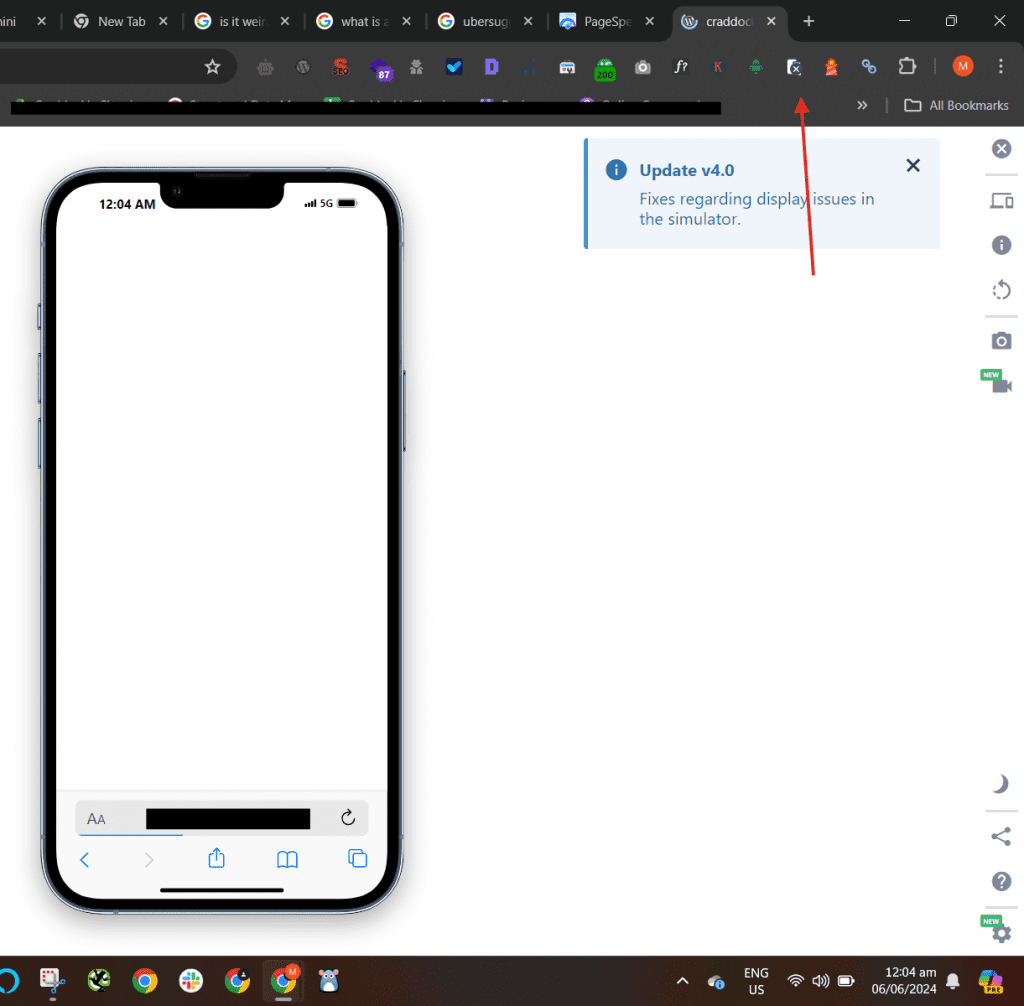
Security
Make sure all pages on the website are riding on an https:// protocol.
If all other factors are considered equal, Google will typically rank the site on a secure protocol over a website which is not.
Your web developer will generally understand how to redirect your non-secure pages to their https:// counterparts.This requires some backend work in the htacces file.
If you aren’t sure if you have https:// pages, go into the site, choose a random page on an https:// protocol.
Then, type the https:// version of it by simply removing the “s” from the address.
If the page redirects you to the https:// version, congrats, it’s secure!
URLs
Imagine the website as a well-organized filing cabinet.
Each drawer represents a main category (like “Services” or “About Us”), and within each drawer, you have folders for specific items (like “Office Cleaning” or “Carpet Cleaning”).
The URL is like the label on each folder, showing the path to find that specific content.
In the example https://yourdomainname.com/services/specific-service-name:
- yourdomainname.com: The cabinet itself, representing your main website.
- /services/: A drawer in the cabinet, showing that this page is in the “Services” category.
- /specific-service-name: A folder within the drawer, indicating the specific service offered (e.g., “office-cleaning”).
Things to avoid in your URL structure:
- Unnecessarily long URLs: Keep them concise and easy to read.
- Duplicate URLs: Make sure each page has a unique URL to avoid confusing search engines. Different URLs serving similar content will be counted as duplicates. Either redirect the duplicate or add a canonical link element.
- Non-ASCII characters: Stick to standard letters, numbers, and hyphens for compatibility.
- Underscores: Search engines prefer hyphens to separate words in URLs.
Auditing and fixing issues in your URL structure helps visitors navigate the site easily, and also helps Google understand where each page is, relative to another.
Indexability and crawlability
Make sure the site is indexable and crawlable!
A lot of people confuse the two terms together, but basically crawlability refers to the ability of search engine spiders to “crawl” the website and discover its content and various other pages through links.
Crawl rules can be checked via the website’s robots.txt file.
Meanwhile, indexability refers to the ability of a website to appear in the search results.
This means a page can be crawlable but if there is a noindex tag or there is something else preventing it from appearing on search, it cannot be discovered.
It’s normal for websites in development to accidentally forget to remove the noindex tag.
This step should be added to the checklist once the site is about to go live.
So if you have a website that’s just recently launched, make sure to get your developer to remove the noindex tag on all pages. A quick way to check the pages indexed on Google is through the site: operator.
Ex:
Type the following in Google’s search bar
site:yourdomainname.com
A list of the pages that have been indexed by Google on the website will appear as the results. Take note that this doesn’t show ALL pages, only some of them. But it does give you a good idea.
Tracking indexed pages via Google Search Console
To track all pages indexed on the site, connect it to Google Search Console. Follow the verification steps.
For a plug-and-play method, install a header tag plugin on WordPress, copy the script, then paste it into the corresponding header tag box or field on your homepage.
Give GSC a few days or even several weeks to show data. Newer sites may take longer, but they should appear once everything is done right.
Tracking indexed pages via a Chrome extension browser
Download the Robots Exclusion Checker Chrome extension. Open a page on your website. The robot icon will light up green if there are no tags or rules disallowing the page from being indexed on Google.
The robot will light up red if there is a noindex tag or some other exclusion. Click on the icon to view more details, then click on each dropdown for further inspection.
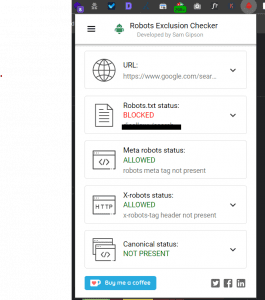
Don’t Forget Off-Page SEO
When it comes to ranking a commercial cleaning website on search engines, on-page is crucial, but that doesn’t mean you should completely forget the off-page part.
Off-page refers to techniques that are not done on the website. These are:
- Building citations through submitting the business details to online directories (free or paid).
- Optimizing your Google Business Profile for local search.
Optimizing your Google Business Profile Listing
Contrary to popular belief, you don’t need to hire a local SEO agency or expert to optimize your Google Business Profile.

Setting it up means you’ve got the basics in the bag.
But if you want to take your local search optimization a step further for your commercial cleaning business, follow these steps:
- Make sure all your listings have NAP (Name, Address, and Phone Number consistency). For example, your commercial cleaning business is called “Smith Commercial Cleaners”, and this is the registered business name.
- Do not add keywords in the business name unless it is registered with it. For example Smith Commercial Cleaners In Dallas. If the Dallas part isn’t part of the actual registered business name, do not add it in the title. This goes against Google’s guidelines.
- All listings you have submitted online should have the name as it appears. Not just “Smith”, or “Smith’s Cleaning Services”. The same goes for your address, how it’s presented, and the phone number.
- Add a primary category that applies to the business. Use GBP’s predefined categories and add all the relevant predeefined services that you offer.
- Fill out as much information as possible. Ideally, no field is left blank. Give the most information to the user, regarding the business hours, special hours, website, booking link, etc.
- Get customer reviews. There is an option on the GBP dashboard of your profile to get more reviews from your clients. Click on it, and you’ll receive a link which you can send your clients.

Ask them to leave reviews if they’re satisfied with the service. You can even go a step above and ask your client if they can offer a complimentary clean or a discount off the next cleaning session for their clients. Get creative.
Building citations
It’s understandable that you don’t have the budget yet for paid citations, so let’s stick to the free options.
While the purpose of online citations is to get the business listed in as many directories as possible and to increase brand awareness and visibility, there’s also a backlink element to it.
Citations from reputable directories like Yelp, Tripadvisor, Yellow Pages, Foursquare, Bing Places, Apple Maps, and the like also “vouch” for the website in a way.
So if you haven’t yet, create a profile on any one of these online directories, follow NAP consistency, add actual business photos for credibility and social proof, and regularly audit them.
Be sure to inform your client about this. They might already have existing listings online that you just need verification for, to make changes.
For example, the business has just switched from residential to commercial cleaning. You’ll need to go through a verification step for some of the online listings to verify your association with your client’s business.
Just keep them in the loop and tell them to send you any verification links or PINs to confirm your association.
From there, you can remove the “residential” category from the listings and switch it to your current business model or manage the listing as needed.
Do a weekly audit of the website
Audit the website through an SEO tool.
For beginners, it’s recommended to go for affordable, yet great options.
Neil Patel’s Ubersuggest in particular is really good because it’s about 90% cheaper (according to the Ubersuggest website) compared to other SEO tools that work on a monthly or annual subscription basis.
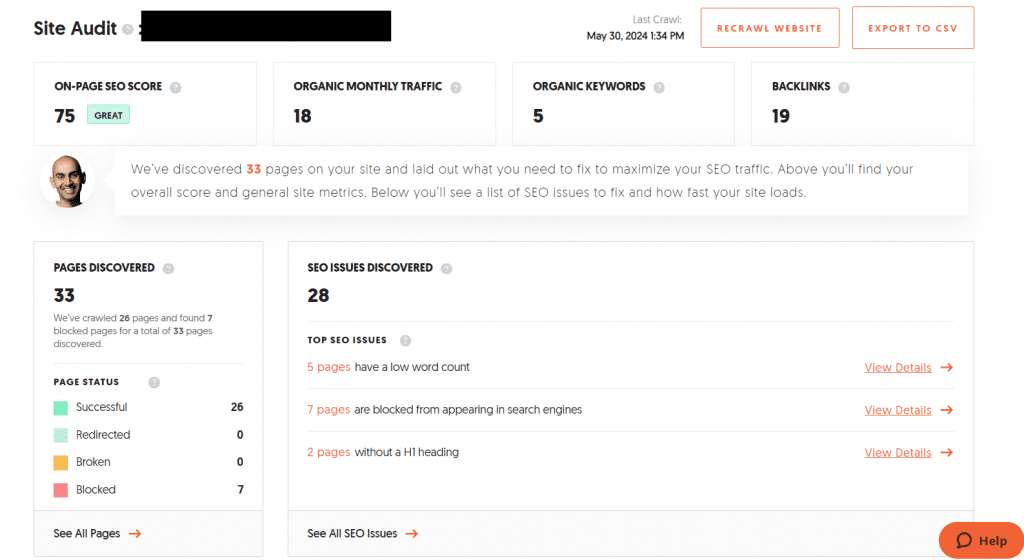
You can get a complete SEO audit tool for a One-Time-Payment of $40. If you’ve run out of audit credits, just purchase add-ons which cost $5 each.
Not the best for a full-suite audit, but good enough to understand critical technical issues in the site and figuring out how to fix them.
Write Service-Based and Industry-Relevant Blogs
It’s true that not all business websites will benefit from blogging. But that’s not entirely the case for commercial cleaning companies.
In fact, for new sites, content marketing will be the lifeblood. Write great, and relevant content that speaks to the business’ target market.
Go for informational-intent long-tail keywords that are also low in competition, and with similar websites of comparable domain authority already ranking for them.
People Also Asked is a great tool for discovering questions that your target audience asks about a particular niche. Just type in a broad keyword like “commercial clean” and you’ll get a matrix or clusters of questions and related questions.
Use these for your blog topics and try to publish at least 2-3 blog posts every week.
Conclusion On Attracting Customers To Cleaning Companies Via SEO
SEO can be unintuitive at times and there’s no hard-and-fast rule to get your site to rank.
But Google does favor websites that are user-oriented — sites that want to make it easy for the user to find the information they need in the shortest possible time. Use this as your guiding star and no SEO strategy you recommend will be detrimental to your site
Don’t be discouraged. Following these best practices allows you to get a footing in SEO marketing for your commercial cleaning client.
SEO is a marathon, not a sprint. Investment in time and consistency is key.
